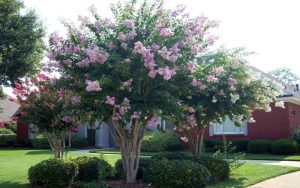How fast crepe myrtles grow
Crepe myrtles, with their enticing blooms and graceful foliage, are highly valued additions to any landscape. Understanding the rate at which these trees grow is critical for properly caring for them. In this comprehensive overview from ArborTrueCA, we dig into the fascinating world of how fast crepe myrtle grows. From the elements that influence their growth to the best procedures for cultivation and upkeep, we’ll give you everything you need to cultivate healthy, colorful crepe myrtles in your garden. Whether you’re an experienced gardener or a beginner, this book will provide you with the knowledge and tactics you need to ensure optimal growth and blooming flowers. Join us as we explore the wonders of crepe myrtle growth and learn the secrets of cultivating these magnificent trees.
How fast do crepe myrtles grow
Under ideal planting conditions, the common crape myrtle can reach heights of 15-25’ and a spread of 6-15’. This shrub grows typically topping 24’ in height per year. Full sun is the ideal condition to plant crepe myrtles, a minimum of 6 hours of direct, unfiltered sunlight daily is preferred for optimal growth. Crape myrtles take approximately 5-7 years to mature although this time can vary depending on various factors such as specific cultivation growing factors and care conditions.
What can shorten the life span of crepe myrtles?
Poor Soil Drainage: Excessive moisture around the roots from poorly drained soil can cause root rot and other fungal diseases, jeopardizing the tree’s health and longevity.
Improper Pruning: Incorrect pruning procedures, such as over-pruning or pruning at the incorrect time of year, can damage the tree’s structure, increase disease susceptibility, and shorten its lifespan.

Pest Infestations: Serious infestations by pests such as aphids, scale insects, or powdery mildew can weaken the tree and cause substantial harm, potentially limiting its lifespan if not handled.
Disease: Fungal diseases like powdery mildew, Cercospora leaf spot, and sooty mold can infect crepe myrtles, weakening them and shortening their lifespan if not treated appropriately.
What can increase the life span of crepe myrtles
Several activities can help extend the lives of crepe myrtles.
Soil condition: Planting crepe myrtles in well-drained soil with enough sunlight encourages good root development and overall growth, resulting in a longer lifespan.
Regular Watering: Consistent watering, especially during dry months, helps to maintain soil moisture levels and avoids drought stress, which benefits the tree’s health and longevity.
Mulching: Applying a layer of organic mulch around the tree’s base helps conserve soil moisture, control temperature, and discourage weeds, resulting in ideal growing circumstances for crepe myrtles and increasing their lifespan.
Pruning crepe myrtles properly, which includes removing dead or diseased branches, optimizing air circulation, and shaping the tree, boosts structural integrity, lowers disease risk, and increases tree lifespan.
Pest and Disease Management: Regular pest and disease monitoring, as well as prompt intervention, such as applying appropriate treatments or establishing cultural practices to prevent infestations, helps to maintain and ensure the longevity of crepe myrtles.
Fertilization: Providing appropriate fertilization based on the tree’s demands can supplement soil nutrients, promote healthy growth, and increase overall vigor, resulting in a longer lifespan.
Growth Rate of Crepe Myrtles in Different Environments
Crepe myrtles’ growth pace varies greatly depending on the environmental conditions in which they are placed. Crepe myrtles grow quickly in areas with warm, temperate weather and plenty of sunlight. These conditions create an optimal environment for photosynthesis and nutrient absorption, resulting in robust growth and prolific flowering.
Crepe myrtles may grow at a slower rate in cooler climes or regions with inadequate sunlight. Cold temperatures and short growing seasons can stifle growth and delay the development of new shoots and foliage. Furthermore, soil quality and moisture levels can influence growth rates, with well-drained, fertile soil promoting faster development than compacted or nutrient-deficient soils.
Seasonal Variations in Growth
Crepe myrtles’ growth patterns are significantly influenced by seasonal fluctuations. Crepe myrtles grow most actively in the spring and summer when temperatures are higher and daylight hours are longer. New shoots develop, leaves unfold, and flowers blossom, causing the tree’s canopy to grow and expand rapidly.

In contrast, growth rates tend to decelerate throughout the fall and winter months as temperatures drop and daylight hours shorten. Crepe myrtles endure a period of dormancy during which growth is reduced or stopped completely. This permits the tree to preserve energy while preparing for the colder months ahead. Overall, understanding seasonal growth fluctuations can help gardeners predict and plan for changes in crepe myrtle look and behavior throughout the year.
Common Challenges and Solutions
Crepe myrtles are generally hardy trees, although they can confront problems that impede their growth and health. One typical problem is powdery mildew, a fungal disease that causes a white, powdery coating on the leaves. To prevent powdery mildew, keep sufficient air circulation around the tree and minimize overhead watering. Furthermore, using a fungicidal spray may help control the condition.
Another issue is aphid infestation, which can result in deformed growth and honeydew secretions. To combat aphids, introduce natural predators such as ladybugs or rinse the tree with a strong spray of water to flush out the pests. Furthermore, crepe myrtles may not flower well due to incorrect pruning or environmental stress. To enhance blossoming, give the tree proper maintenance, including pruning, fertilizer, and watering, and make sure it gets enough sunlight. Regular monitoring and prompt intervention can assist overcome these problems, allowing crepe myrtles to maintain their health and beauty.
FAQS
Do crepe myrtles prefer full sunlight or shade?
Crepe myrtles thrive in direct sunlight, requiring at least 6-8 hours per day for best growth and flowering.
How often should I water my newly planted crepe myrtles?
Newly planted crepe myrtles should be irrigated regularly to keep the soil moist but not saturated. Water thoroughly once or twice every week, depending on the weather.
Can I prune crepe myrtles to limit their growth?
Yes, crepe myrtles can be clipped to maintain their size and shape. Pruning should be done during the dormant season to encourage strong growth and prolific flowering.
Conclusion
Finally, understanding the factors that influence crepe myrtle growth is critical for developing healthy, vibrant trees. Gardeners may promote optimal development and flowering by taking into account environmental factors, seasonal fluctuations, and correct maintenance procedures like watering, fertilization, trimming, and insect management. Crepe myrtles give beauty and charm to landscapes with their gorgeous blossoms and graceful leaves, making them popular in gardens, parks, and on roadways. Gardeners who are diligent and pay attention to detail can overcome typical obstacles and enjoy the rewards of lush, blooming crepe myrtles for many years. Remember to routinely assess the tree’s health, act as needed, and continue to offer the care and maintenance it requires to grow. Crepe myrtles can be nurtured with care and attention.
Related Post




